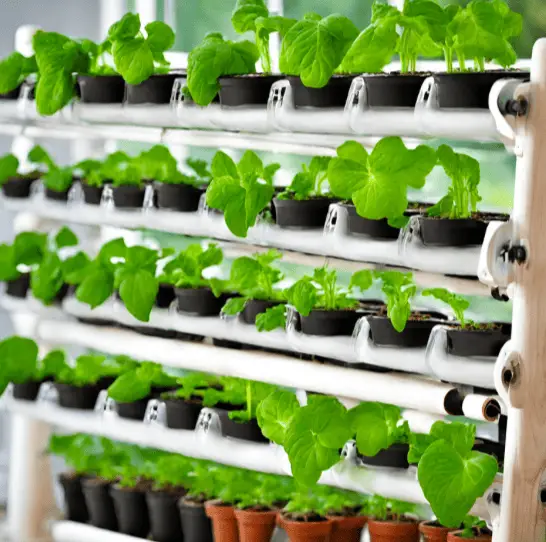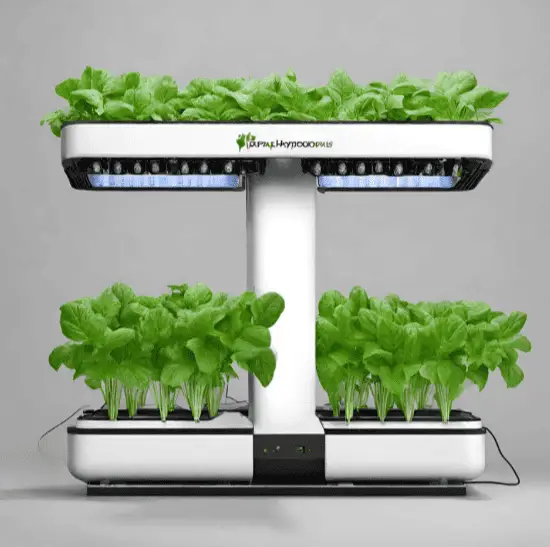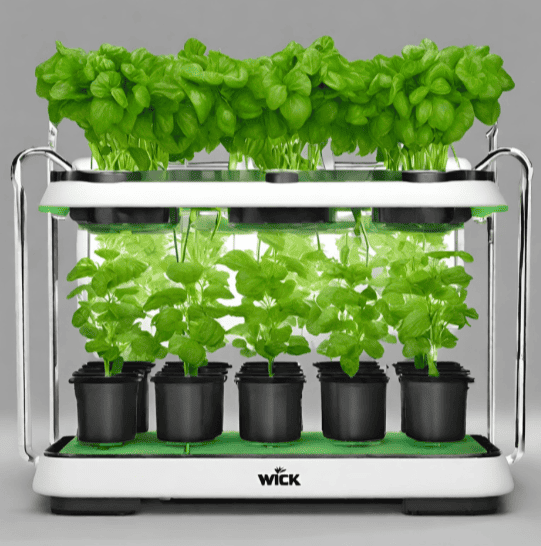Hydroponics is a popular method of growing plants without soil, using nutrient-rich water instead. This technique has been gaining popularity due to its many benefits, including the ability to grow plants in small spaces and the reduced need for water and fertilizers.

Diving into the world of Do It Yourself hydroponics for home is like embarking on a green-thumbed adventure right in your living room. Whether you’re a seasoned gardener or just dipping your toes into horticulture, this fascinating method offers a playful twist to traditional soil-based growing, and it’s all about nurturing your plants without getting your hands too dirty. So, ready to turn your home into a vibrant oasis of leafy wonders?
KEY TAKEAWAY
How DIY home hydroponics offer sustainability and efficiency, reaping benefits?
DIY hydroponics for home offers a sustainable, water-efficient, and year-round gardening solution that reduces water usage by up to 90% compared to traditional soil-based methods. It enables individuals to cultivate fresh and nutrient-rich produce in the comfort of their own space, making it an environmentally friendly and rewarding choice for both seasoned gardeners and beginners.
DIY Hydroponics for Home
Hydroponics, a soilless way to grow plants, offers a world of possibilities. It’s like gardening’s science fiction, where you can cultivate lush gardens without ever touching soil. One fascinating aspect is the variety of methods available to set up a hydroponic system. And here’s the kicker: it can be cost-effective, beating traditional gardening at its own game.
But how do you get started? Well, you have two paths. You can roll up your sleeves and craft your very own hydroponic system using everyday items. Or, if you prefer a ready-made solution, there’s the option to purchase a pre-assembled system. The choice is yours, and both offer unique experiences.
The heart of hydroponics is the nutrient solution. Think of it as plant smoothies. This concoction contains the water and essential nutrients that your green pals need to flourish. (1) Now, you have a choice. You can become a mad scientist in your kitchen, mixing up your own nutrient solution using various recipes you can find. Or, for the no-fuss route, you can simply visit a garden center and grab a professionally formulated one. Your call!
Once you’ve got your nutrient solution dialed in, it’s showtime. Setting up your hydroponic garden is a breeze. It’s like piecing together a puzzle – each part fits neatly into place, and you’ll soon see your creation come to life.
And the magic doesn’t stop there. With a hydroponic system, you can garden indoors. That’s right, 365 days a year. Imagine fresh flowers, herbs, and veggies, no matter the season. It’s a gardening dream come true.
Kratky Hydroponics System

Creating a Kratky hydroponic system is as straightforward as a summer breeze. Whether you’re just dipping your toes into the world of hydroponics or you’re a seasoned gardener looking for an efficient, budget-friendly method, the Kratky system has you covered.
Named after Dr. Bernard Kratky, an esteemed professor emeritus at the University of Hawaii, this hydroponic gem is all about simplicity. What’s more, it doesn’t require any fancy machinery or complex contraptions. All you need is a container, a growing medium, and, of course, your beloved plants.
It’s particularly fantastic for cultivating leafy greens and fresh herbs. Think of it as a beginner’s paradise in hydroponics. You can dip your toes in without emptying your wallet. The Kratky method is all about relying on good ol’ gravity to do the work for you.
Now, how can you get started? Well, we’ve got you covered with an easy-to-follow instructional guide. It’s like having your own hydroponics mentor, taking you step by step through the process. And the best part? It’s all done without overwhelming you with technical jargon or breaking the bank.
So, what’s the Kratky system all about? It’s about simplifying hydroponics, making it accessible to everyone. With minimal equipment, it’s a budget-friendly choice. It’s your ticket to growing fresh, healthy greens right in your own space. It’s your entry point into the captivating world of hydroponics.
Deep Water Culture (DWC)
Looking for a hydroponics system with some added flair, but without the fuss? Consider the Deep Water Culture (DWC) system. It’s like the Kratky system’s cousin – simple, cost-effective, and it doesn’t involve any complex equipment or moving parts.
What sets the DWC system apart is how it handles the nutrient solution. In this hydroponic wonder, the solution is oxygenated, and the plant roots are fully immersed in it. It’s like giving your plants a spa day, complete with a nutrient-rich soak.
Now, why would you choose a DWC system? For starters, it’s a breeze to install and maintain. If you’re dreaming of a lush lettuce or kale garden, this is your go-to hydroponic method. Rapidly growing plant species thrive in this system, thanks to its efficient delivery of nutrients and oxygen to the roots.
But the best part is the simplicity. No need for complex machinery or fussy setups. With DWC, you’re diving into hydroponics with style and substance, ensuring your plants get the royal treatment they deserve.
Wick Hydroponic System

If simplicity and low-maintenance are your top priorities in a hydroponics system, then you’re in for a treat with the wick hydroponics system. It’s like the hassle-free gardener’s dream come true.
Wick hydroponics is all about ease. Picture this: your plants nestled in containers filled with a special wicking material. This material acts like a plant’s personal butler, drawing water and nutrients from the reservoir and delivering them straight to the roots. It’s like having a 24/7 room service for your plants.
Who should consider wick hydroponics? Well, if you’re new to hydroponics or simply don’t have the time or energy for a complex setup, you’re the ideal candidate. It’s the perfect choice for those who want to dip their toes into the hydroponic world without feeling overwhelmed.
Conclusion
As our journey through the captivating world of DIY hydroponics for home draws to a close, let’s wrap it up with a bow and a garden full of wisdom. Whether you’re a seasoned gardener or a greenhorn, hydroponics offers a magic touch, delivering faster, more efficient plant growth while using a remarkable 90% less water than traditional gardening. The real enchantment lies in the vibrant flavors, colors, and nutrients of your homegrown produce, making it an absolute culinary delight. And the best part? It’s as easy as pie!
So, don’t wait – delve into our other articles for more tips and secrets to elevate your hydroponic journey. Your taste buds and wallet will thank you. Keep growing and keep reaping the rewards – it’s a win-win!
Frequently Asked Questions
What is hydroponic gardening, and how does it work?
Hydroponic gardening is a revolutionary way of growing plants without soil. It’s like a science experiment in your own backyard. The plants are grown in a soilless medium like coconut coir or perlite, placed in containers like net pots, and then suspended in a nutrient-rich water solution. It’s all about pampering your plants, delivering nutrients directly to their roots.
What are the key components needed for a DIY hydroponics setup?
To get started, you’ll need net pots, a water pump, PVC pipes, and a reservoir to hold your nutrient solution. Add a few key elements like grow lights, LED grow lights are excellent, an air pump with air stones, and a system like the Nutrient Film Technique (NFT) or Deep Water Culture (DWC). These are your tools for a thriving hydroponic systems.
How can I make my own nutrient solution for hydroponic gardening?
You can create your nutrient solution by mixing water and hydroponic nutrient concentrates, which are readily available. Follow the manufacturer’s recommendations, and always use tap water. The nutrient balance is crucial to plant growth, so be mindful of its composition.
Can I use hydroponics to grow any type of plant?
Absolutely! Hydroponics can grow a wide range of plants (2), from herbs and vegetables to fruits and flowers. The possibilities are endless. Just keep in mind that each type of plant may require different nutrient levels and care.
How often should I check and adjust the water level in my hydroponic system?
Your hydroponic garden is a bit like a ship sailing the seas of nutrient-rich water. Check the water level daily and top it off as needed to ensure the roots of the plants are always submerged. It’s all about maintaining the perfect environment for your plants.
What’s the best way to deal with plant pests and diseases in a hydroponic system?
Think of your hydroponic garden like a fortress. Pests and diseases are less likely to invade, but they can’t be entirely ruled out. Regularly inspect your plants and maintain good hygiene. If trouble arises, consider introducing beneficial insects like ladybugs to your hydroponic garden.
How much time should I dedicate to a DIY hydroponic system?
Hydroponic gardening is not a 24/7 commitment, but it’s like taking care of a pet. You’ll need to dedicate a bit of time daily to check on your plants, monitor nutrient levels, and adjust the system. Think of it as a labor of love that rewards you with fresher-than-fresh hydroponic food.
What are some insider tips to ensure a successful DIY hydroponics adventure?
Keep an eye on your plants’ roots; they tell you a lot about their health. Avoid overfeeding your plants with nutrients, maintain consistent lighting with grow lights, and ensure a well-ventilated system.
Related to DIY Hydroponics for Home – Indoor Hydroponic Garden DIY
Was this helpful?

Crystal Erickson is an agriculture enthusiast and writer with a passion for sustainable farming practices and community development. Growing up on a family farm in rural Iowa, Crystal developed a love for the land and a deep appreciation for the hard work and dedication required to make a farm successful.
After completing a degree in Agriculture and Environmental Science from Iowa State University, Crystal began her career as an agricultural journalist, covering stories and issues related to modern farming practices, crop management, and livestock production. She quickly established herself as a respected voice in the industry, known for her insightful reporting and thoughtful analysis.
Over the years, Crystal has written for a variety of publications, including Farm Journal, Successful Farming, and Modern Farmer, as well as contributing to several academic journals focused on sustainable agriculture and community development. Her work has been recognized with numerous awards, including the Iowa Farm Bureau’s Young Farmer Achievement Award and the National Association of Farm Broadcasting’s Farm Broadcaster of the Year.

